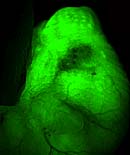Articles and reports from the Life Sciences and chemistry area deal with applied and basic research into modern biology, chemistry and human medicine.
Valuable information can be found on a range of life sciences fields including bacteriology, biochemistry, bionics, bioinformatics, biophysics, biotechnology, genetics, geobotany, human biology, marine biology, microbiology, molecular biology, cellular biology, zoology, bioinorganic chemistry, microchemistry and environmental chemistry.

A fruit fly gene called radish, and the newly identified protein it encodes, have opened doors to understanding the genes and neuronal networks that govern a special type of memory, termed anesthesia-resistant memory. Researchers had previously known that for most animals — not just humans — loss of consciousness from anesthesia causes amnesia for recently experienced events. In contrast, for reasons that are not well understood, older memories are resistant to the effects of anesthesia. With the h

The recent marriage of evolutionary biology with developmental biology has resulted in the birth of a new field, evolutionary developmental biology, or “evo-devo.” Evo-devo scientists study the mechanisms that produce evolutionary changes in body plans over time. As one of the field’s creators, Indiana University Bloomington biologist Rudolf Raff brings new understanding to the evolution of humans and other organisms by uniting fossil data and information about the genes that control development

Researchers have successfully cloned a mouse using mature olfactory neurons as the genetic donor. The scientists credit the idea for the experiments to Woody Allen whose classic comedy Sleeper depicted scientists who try to clone a dead dictator from his nose.
The current study aims to answer longstanding questions about the developmental potential of mature cells. In doing their experiments, the researchers were seeking to determine whether a single mature olfactory neuron, when introduced

Scientists have created an unlimited supply of a type of nerve cell found in the spinal cord – a self-renewing cell line that offers a limitless supply of human nerve cells in the laboratory. Such a supply has long been one goal of neurologists anxious to replace dead or dying cells with healthy ones in a host of neurological diseases.
In this study, appearing in the March issue of Nature Biotechnology, the scientists then used the cells to partially repair damaged spinal cords in laborator

The fossil remains of early humans gave generations of scientists the clues needed to piece together much of our ancestral lineage. Chi-Hua Chiu now leads us into another dimension in the study of human origins: the underlying developmental and genetic processes that led to these remarkable evolutionary changes.
“To develop a better understanding of the genetic basis of human evolution, we must discover specific relationships between particular genetic changes and their resulting effects on

Advances in genetics during the last decade not only have influenced modern medicine, they also have changed how human evolution is studied, says an anthropologist from the University of Illinois at Urbana-Champaign.
Using her own research on the teeth of baboons as a case in point, Leslea J. Hlusko said that some of the traits considered important to human evolution, such as the thickness of molar enamel, may be too simplistically interpreted by some paleontologists.
Hlusko organ